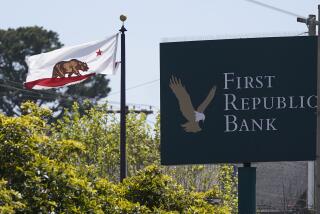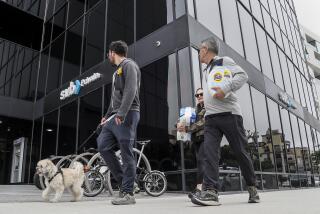1st S&Ls; Seized by U.S. in Bush Bailout Plan
WASHINGTON — Federal regulators Tuesday seized control of four large and insolvent savings and loan associations, including Pacific Savings Bank of Costa Mesa, to stem financial losses until Congress acts on President Bush’s new proposal to bail out depositors at failed S&Ls.;
The 60 federal officials who entered S&Ls; in California, Maryland, Florida and Texas were the vanguard of an army of more than 1,200 who will take over 224 insolvent institutions in the next few weeks.
No Effect on Customers
Customers will notice no immediate differences in S&L; operations. “We are not going in there and ripping up the boards,” L. William Seidman, chairman of the Federal Deposit Insurance Corp., told a news conference. “The only way (anyone) can tell we are there will be a couple more people” in the offices, Seidman said.
However, the federal regulators will have the power to review and alter any business activities, to hire and fire management, to rewrite the rules governing loans and to change interest rates offered to depositors.
Because many insolvent S&Ls; have been offering unusually high interest rates to attract funds, it seems likely that the regulators will order their rates lowered. Current accounts and existing cerficates of deposit would not be affected, but those opening new accounts probably no longer would be offered rates higher than the levels prevailing in the rest of the S&L; industry.
“We do not want institutions bidding against each other and bidding up the cost of funds,” said Bill Roelle, the FDIC’s associate director.
The seizure of insolvent S&Ls; was ordered by Bush because the insurance fund that guarantees S&L; deposits of up to $100,000 lacks the cash needed to close the crippled institutions and pay off depositors. The federal regulators will seek to stem further financial losses at the S&Ls; they seize, thus holding the cost of guaranteeing deposits to a minimum.
“We are combining the resources of all federal regulators so adequate personnel will be available to move swiftly to take control of all institutions that are insolvent,” Seidman said. He was joined at the news conference by M. Danny Wall, chairman of the Federal Home Loan Bank Board, which regulates S&Ls; and also operates their federal insurance fund.
Under the President’s plan, the S&L; insurance fund would be put under the control of the FDIC, which regulates banks. The Federal Home Loan Bank Board, reduced to an agency to charter and regulate S&Ls;, would become part of the Treasury Department.
Personnel from the bank board, the Office of the Comptroller of the Currency and the Federal Reserve Board will participate in the seizure of the S&Ls;, but the dominant role will be played by the FDIC, which has thousands of examiners and financial experts.
“We may have a few hundred--they have a few thousand,” Wall said.
All the S&Ls; seized Tuesday were major institutions suffering continuing heavy financial losses. Pacific Savings has assets of $1.1 billion, deposits of $1 billion and 49,343 accounts. The others are Baltimore Federal Financial, with assets of $1.7 billion; Freedom Savings & Loan of Tampa, Fla., $1.5 billion, and Gill Savings of Hondo, Tex., $1.3 billion.
Altogether, there are about 350 bankrupt S&Ls; nationwide, according to regulators. But only 224 of them meet standards that permit regulators to seize them without congressional approval.
Disposing of crippled S&Ls; by closure or sale will cost an estimated $90 billion, the Bush Administration says. About $40 billion had been committed by regulators before this year, and Bush proposed to raise the additional $50 billion through the sale of bonds.
Interest and principal repayments on the bonds would be financed by a combination of taxpayer funds, the sale of assets of failed thrift institutions and higher premiums on S&Ls; for their federal deposit insurance. In addition, banks would be forced to pay higher insurance premiums to bolster their deposit insurance fund.
The banks and S&Ls; may pass along to their customers some or all of the additional costs of their deposit insurance.
A Treasury Department official said that the Bush plan anticipates recovering 40 cents to 60 cents on each dollar of failed S&L; loans that underwrote apartment buildings, office buildings, residential developments and condominiums. The total expected proceeds are $21 billion over 10 years.
But many of the bad loans are in the depressed Texas real estate market, and recovering even 40 cents on the dollar there may be difficult. Whatever the government cannot raise that way would have to be paid by taxpayers.
The $90-billion price tag for the S&L; cleanup swells to total spending of about $126 billion over the next 10 years when interest costs on the bonds are included, Treasury officials said Tuesday. No previous estimate of bond interest payments had been given.
Senate leaders promised to move quickly on the Bush plan. In a bipartisan move, Donald W. Riegle Jr. (D-Mich.), chairman of the Senate Banking, Housing and Urban Affairs Committee, said that he and Sen. Jake Garn of Utah, the panel’s top-ranking Republican, will sponsor the Administration’s program jointly.
“I am determined to see us act quickly in the committee to match the speed of the Administration,” Riegle said. “When we are losing on the order of $33 million a day (from S&L; operating losses), all of us are under enormous responsibilities to get this package done.”
In the House, Henry B. Gonzalez (D-Tex.), chairman of the Banking, Finance and Urban Affairs Committee, said that he hopes for a vote by his committee on a complete bill by the first week in March.
Bush has also asked Congress for $50 million to prosecute S&L; executives whose illegal activities helped drive institutions into insolvency. The money would be used for hiring up to 200 additional FBI agents and 80 to 85 additional prosecutors to concentrate on savings and loan issues, according to a proposal under consideration by Atty. Gen. Dick Thornburgh.
Related stories in Business.
More to Read
Inside the business of entertainment
The Wide Shot brings you news, analysis and insights on everything from streaming wars to production — and what it all means for the future.
You may occasionally receive promotional content from the Los Angeles Times.










